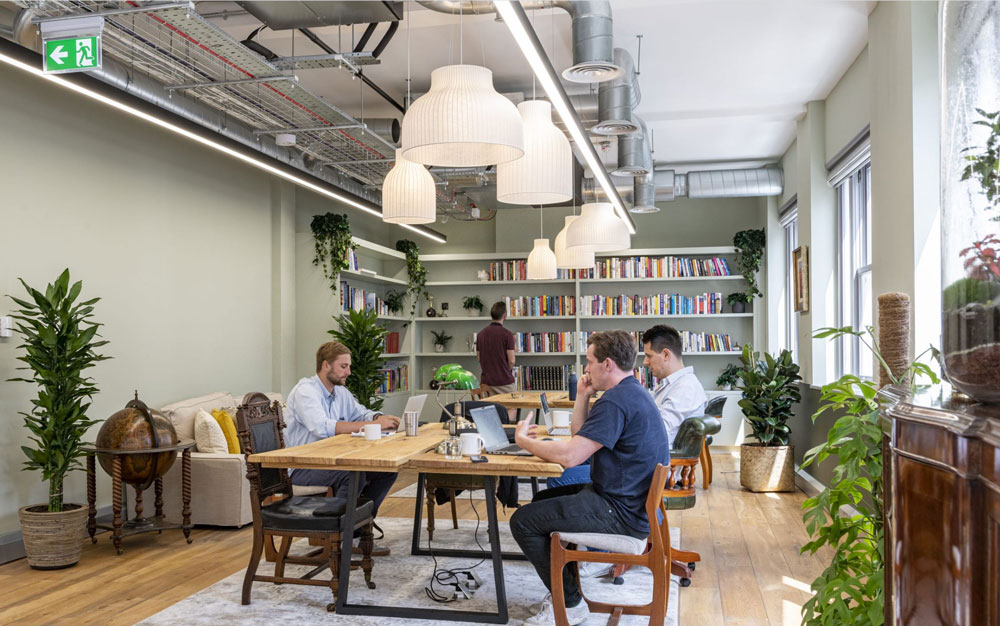How does taking note of circadian rhythms and incorporating plants in an office help your employees? For those managing an office, it’s important to realise that you’re not just overseeing a physical space—you’re nurturing an environment where people spend a large portion of their day. Their well-being is pivotal, and it’s deeply intertwined with circadian rhythms – the invisible but ever-present cycles that manages our internal body clocks.
Circadian Rhythms: Nature’s Schedule
Circadian rhythms are our body’s built-in clock. They govern not just our sleep-wake cycle but also influence our energy levels, digestion, and even how we process emotions. This internal timing is designed to sync with the natural world’s cycle of daylight and darkness.
However, the modern office often disrupts these natural rhythms. The hum of artificial lighting and the glow of computer screens can confuse our internal clocks. This leads to common workplace woes: that mid-afternoon slump, the struggle to focus, or the widespread issue of poor sleep quality among employees.
The Power of Plants – More Than Just Ornamental
Enter the humble office plant, a silent sentinel that does more than just beautify the space. Plants have their own circadian rhythms, opening their leaves to the light of day and closing them as dusk falls. They serve as a living reminder of the world outside, providing subtle cues to our own biological clocks.
Here’s what science says about the benefits of plants in the workspace:
- Boosting Alertness and Productivity: Research has shown that just a glimpse of green can spark creativity and increase productivity. Plants can help reduce the feelings of mental fatigue, keeping our minds sharper and more focused.
- Reducing Stress and Promoting Well-being: Studies have found that the presence of plants in the office can lower stress levels. This is no small feat, considering the high stress many workers experience daily. The calming influence of plants can create a more serene environment, which in turn can lead to improved employee morale.
- Improving Sleep and Supporting Health: Good sleep is the cornerstone of good health. Plants can influence the quality of our rest by reinforcing the natural rhythm of day and night, helping us wind down when it’s time to leave the office behind.
The Philosophy of Biophilic Design
The term “biophilic design” may sound complex, but its principle is simple: integrate nature into architecture and interiors. Pioneered by biologist E.O. Wilson in the 1980s, it draws on the inherent human affinity for the natural world. This philosophy advocates for workplaces that are not just functional but also nurture the well-being of those who inhabit them.
Historically, humans have always been close to nature. Our ancestors worked under the open sky, and it’s only in relatively recent times that we’ve boxed ourselves into indoor spaces. Biophilic design seeks to rectify this disconnect by bringing natural elements back into our daily spaces.
Creating A Healthy Habitat for Workers
Embracing biophilic design isn’t just about putting a few potted plants around the office. It’s about creating an ecosystem that supports health and productivity. This can be achieved through:
- Maximising Natural Light: Positioning desks and communal spaces to benefit from natural daylight can keep our circadian rhythms in check, making us more alert during the day and ready to rest after sundown.
- Diversifying Plant Life: A variety of plants not only contributes to the visual appeal of the office but also supports a broader range of natural functions. Some plants are particularly adept at cleaning the air, while others may thrive with less light, fitting perfectly into different corners of the office ecosystem.
- Ensuring Good Plant Health: A neglected plant can be counterproductive. Regular care for these living decor elements is essential. A healthy plant is a thriving participant in the workspace, actively contributing to the air quality and the overall vibrancy of the office.
- Smart Plant Placement: Beyond individual desks, consider larger plant installations in common areas. Green walls, also known as living walls, can be both a statement piece and a natural air filter, while strategically placed plant clusters can act as natural space dividers that also improve the workspace’s look and feel.
The Ripple Effects of a Plant-Filled Office
The influence of a well-planned plant presence in an office goes beyond individual well-being. It can affect team dynamics, with shared care for plants fostering a sense of community and collaboration. It’s also a visual commitment to sustainability, a value increasingly important to employees and clients alike.
Furthermore, the presence of plants can have a subtle yet significant impact on the perceived value of the space. A well-maintained array of plants signals care and attention to detail, qualities that reflect positively on the company’s brand.
Growth, Well-being, and the Green Office Revolution
Introducing plants into the office is a step towards a more organic, healthy, and productive workplace. It’s a nod to the intricate balance between our work lives and the natural world. By fostering an environment where natural rhythms are respected, we not only enhance the well-being of our employees but also plant the seeds for a more harmonious and sustainable future.
If you are an office manager looking to transform your workspace into a thriving and productive environment where employees flourish, reach out to Exubia today.
Our team of qualified project consultants will help you throughout the process of implementing biophilic design and create an office space for you, that inspires your employees, resulting in a greener, healthier and more productive workspace.


Recent Comments